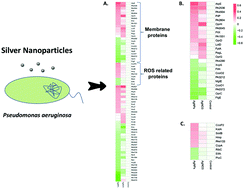当前位置:
X-MOL 学术
›
Metallomics
›
论文详情
Our official English website, www.x-mol.net, welcomes your
feedback! (Note: you will need to create a separate account there.)
Antibacterial mechanism of silver nanoparticles in Pseudomonas aeruginosa: proteomics approach†
Metallomics ( IF 2.9 ) Pub Date : 2018-03-20 00:00:00 , DOI: 10.1039/c7mt00328e Xueting Yan 1, 2, 3, 4, 5 , Bin He 1, 2, 3, 4, 5 , Lihong Liu 1, 2, 3, 4, 5 , Guangbo Qu 1, 2, 3, 4, 5 , Jianbo Shi 1, 2, 3, 4, 5 , Ligang Hu 1, 2, 3, 4, 5 , Guibin Jiang 1, 2, 3, 4, 5
Metallomics ( IF 2.9 ) Pub Date : 2018-03-20 00:00:00 , DOI: 10.1039/c7mt00328e Xueting Yan 1, 2, 3, 4, 5 , Bin He 1, 2, 3, 4, 5 , Lihong Liu 1, 2, 3, 4, 5 , Guangbo Qu 1, 2, 3, 4, 5 , Jianbo Shi 1, 2, 3, 4, 5 , Ligang Hu 1, 2, 3, 4, 5 , Guibin Jiang 1, 2, 3, 4, 5
Affiliation

|
Silver nanoparticles (AgNPs) are the nanomaterials most widely used as antimicrobial agents in a range of consumer products, due to the environmental release of either the AgNPs themselves or silver ions. Although AgNPs appear to be more potent than silver ions, the mechanism behind the activity is not fully elucidated yet. The most common mechanism of toxicity of AgNPs proposed to date is the release of silver ions and/or the particle-specific functions. In this study, Pseudomonas aeruginosa (a model for Gram-negative bacteria) was treated with AgNPs, and its proteomic response was comprehensively characterized to elucidate the antimicrobial mechanism of AgNPs in the microorganism. In total, 59 silver-regulated proteins (27 up-regulated and 32 down-regulated proteins) and 5 silver-binding proteins were identified. Bioinformatic analysis revealed that interference with the cell-membrane function and generation of intracellular reactive oxygen species (ROS) were the main pathways for the antibacterial effect. The pattern of membrane proteins regulated by AgNPs was similar to that found for silver ions. In addition, the same silver-binding proteins were obtained with both AgNPs and silver ions, which indicated that AgNPs probably affect the cell membrane and react with proteins by releasing silver ions. The elevation of intracellular ROS relative to that with silver ions confirmed oxidative damage caused by AgNPs, which may be ascribed to the nano-characteristics and higher uptake efficiency of the particles. These results demonstrate that the antimicrobial activity of AgNPs is due to the synergistic action of release of dissolved silver ions and particle-specific effects. The proteomic analysis of silver-binding and silver-regulated proteins in the present study provides insight into the mechanism of antimicrobial activity of such nanomaterials.
中文翻译:

铜绿假单胞菌 中银纳米颗粒的抗菌机制:蛋白质组学方法†
由于纳米银本身或银离子的环境释放,银纳米粒子(AgNPs)是在一系列消费产品中最广泛用作抗菌剂的纳米材料。尽管AgNPs似乎比银离子更有效,但该活性背后的机制尚未完全阐明。迄今为止,提出的最常见的AgNPs毒性机制是银离子的释放和/或特定于颗粒的功能。在这项研究中,铜绿假单胞菌用AgNPs处理革兰氏阴性细菌(一种革兰氏阴性菌模型),并对其蛋白质组反应进行了全面表征,以阐明AgNPs在微生物中的抗菌机制。总共鉴定出59个银调节蛋白(27个上调蛋白和32个下调蛋白)和5个银结合蛋白。生物信息学分析表明,干扰细胞膜功能和产生细胞内活性氧(ROS)是产生抗菌作用的主要途径。由AgNPs调节的膜蛋白的模式与银离子的模式相似。另外,用AgNP和银离子获得了相同的银结合蛋白,这表明AgNP可能影响细胞膜并通过释放银离子与蛋白质反应。相对于银离子而言,细胞内ROS的升高证实了由AgNP引起的氧化损伤,这可能归因于纳米特性和颗粒的更高吸收效率。这些结果表明,AgNPs的抗菌活性是由于释放溶解的银离子的协同作用和颗粒特异性作用所致。在本研究中对银结合蛋白和银调节蛋白的蛋白质组学分析提供了对这种纳米材料的抗菌活性机理的见解。这些结果表明,AgNPs的抗菌活性是由于释放溶解的银离子的协同作用和颗粒特异性作用所致。在本研究中对银结合蛋白和银调节蛋白的蛋白质组学分析提供了对这种纳米材料的抗菌活性机理的见解。这些结果表明,AgNPs的抗菌活性是由于释放溶解的银离子的协同作用和颗粒特异性作用所致。在本研究中对银结合蛋白和银调节蛋白的蛋白质组学分析提供了对这种纳米材料的抗菌活性机理的见解。
更新日期:2018-03-20
中文翻译:

铜绿假单胞菌 中银纳米颗粒的抗菌机制:蛋白质组学方法†
由于纳米银本身或银离子的环境释放,银纳米粒子(AgNPs)是在一系列消费产品中最广泛用作抗菌剂的纳米材料。尽管AgNPs似乎比银离子更有效,但该活性背后的机制尚未完全阐明。迄今为止,提出的最常见的AgNPs毒性机制是银离子的释放和/或特定于颗粒的功能。在这项研究中,铜绿假单胞菌用AgNPs处理革兰氏阴性细菌(一种革兰氏阴性菌模型),并对其蛋白质组反应进行了全面表征,以阐明AgNPs在微生物中的抗菌机制。总共鉴定出59个银调节蛋白(27个上调蛋白和32个下调蛋白)和5个银结合蛋白。生物信息学分析表明,干扰细胞膜功能和产生细胞内活性氧(ROS)是产生抗菌作用的主要途径。由AgNPs调节的膜蛋白的模式与银离子的模式相似。另外,用AgNP和银离子获得了相同的银结合蛋白,这表明AgNP可能影响细胞膜并通过释放银离子与蛋白质反应。相对于银离子而言,细胞内ROS的升高证实了由AgNP引起的氧化损伤,这可能归因于纳米特性和颗粒的更高吸收效率。这些结果表明,AgNPs的抗菌活性是由于释放溶解的银离子的协同作用和颗粒特异性作用所致。在本研究中对银结合蛋白和银调节蛋白的蛋白质组学分析提供了对这种纳米材料的抗菌活性机理的见解。这些结果表明,AgNPs的抗菌活性是由于释放溶解的银离子的协同作用和颗粒特异性作用所致。在本研究中对银结合蛋白和银调节蛋白的蛋白质组学分析提供了对这种纳米材料的抗菌活性机理的见解。这些结果表明,AgNPs的抗菌活性是由于释放溶解的银离子的协同作用和颗粒特异性作用所致。在本研究中对银结合蛋白和银调节蛋白的蛋白质组学分析提供了对这种纳米材料的抗菌活性机理的见解。











































 京公网安备 11010802027423号
京公网安备 11010802027423号